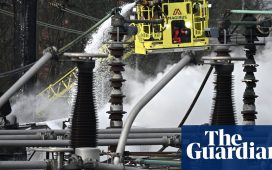Stay informed with free updates
Simply sign up to the UK energy myFT Digest — delivered directly to your inbox.
The UK government is preparing to extend subsidies for Drax’s biomass power station, prompting criticism from campaigners who want the plant to focus on wind and solar technologies.
Ministers have set out proposals by which bill payers will continue to pay a levy to support the UK electricity generator’s station in North Yorkshire beyond 2027 when the current regime expires.
The power station is the biggest in the country, supplying about 4 per cent of the UK’s electricity. It was converted to burn wood pellets instead of coal over the past decade and the original subsidy scheme was introduced to help finance the switchover.
The proposed extension is designed as an interim measure to ensure the plant, which is by far the biggest biomass generator in the UK, stays open as the company fits the power station with technology to capture and store the carbon dioxide it produces. The technology is not expected to be working until the end of the decade.
Biomass generation has been identified by the government as part of its strategy to reduce emissions and reach net zero by 2050.
“Closure of such large-scale biomass plants would hinder their conversion [and] have implications for the UK’s near-term security of supply,” the government said, in a consultation published on Thursday.
The government believes the combination of biomass power generation and carbon capture will help offset emissions from other parts of the economy.
Will Gardiner, chief executive of Drax, said bioenergy with carbon capture was “currently the only credible large-scale technology that can generate renewable power and deliver carbon removals.”
But environmental campaigners are highly critical of the role of biomass, usually made up of wood pellets, in a clean energy system. They question the validity of the argument put forward by supporters that the process is carbon neutral as its emissions are offset by the trees used to produce the fuel sequestering carbon dioxide as they grow.
Doug Parr, policy director at Greenpeace UK, said households “shouldn’t be expected to pay a penny more” to support Drax. “The government should just get on with delivering genuinely green energy solutions, like wind, solar and storage,” he added.
Shares in the FTSE 250 company fell more than 6 per cent on Wednesday. Some analysts blamed the negative reaction on some of the consultation’s support options being potentially less generous than the existing arrangements.
Martin Young, an analyst at Investec, said investors had overreacted, arguing that the proposals were “supportive” for the company.
Under the current subsidy regime, Drax receives a top-up from bill-payers if the wholesale price of electricity falls below a certain level, as well as lump sum payments.
Ember, a non-profit group, has calculated Drax was paid £885mn in 2021 and £617mn in 2022 under these schemes. Exactly how much it could be paid under any future support package beyond 2027 was unclear.
The government said any new subsidy scheme would “be subject to a vigorous value for money assessment.”
Climate Capital

Where climate change meets business, markets and politics. Explore the FT’s coverage here.
Are you curious about the FT’s environmental sustainability commitments? Find out more about our science-based targets here











